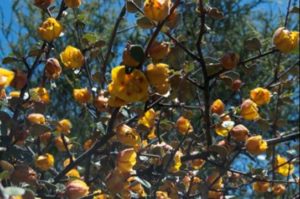by Marti Rutherford
You have probably wandered the nursery isles looking for the ever more popular native plants being sold. Do you ever consider how those plants have been propagated? Many, if not most, native plants in the nursery trade are propagated by cuttings. The nursery person knows what the plant will look like and behave like. And you, the consumer, who has been looking through the native plant books with the gorgeous pictures of the plants in all their glory, want a plant that looks just like that. With cutting grown plants, which are clones of the parent plant, the chances are great that it will behave and look as expected. When the plants are grown from seeds genetic diversity plays its role and the nurseryman cannot promise behavior or look. This makes it difficult for the trade and so they generally do not invest the time and effort in seed grown plants.
But what do we lose when all the plants in the neighborhood are the same genetic material? We lose resilience. We lose potential to survive the next insect or fungal attack. Instead of losing one plant here or there, there is the possibility of losing the neighborhood of plants. After all they all have the same characteristics. A different consideration is that growing from seed is fun. Sure, there can be failures but that makes the successes even sweeter. It’s hard to describe the excitement when a difficult to germinate seed shows its tiny cotyledons. It’s fun to nurture that plant and see it transform into a recognizable individual and to observe whether it is the same as the parent or different. And it’s fun to walk a garden and say I grew that from seed.
There is also the money factor. How many Fremontodendrons have I purchased at more than $10 only to have them die for some reason? When I have numerous babies that I have grown from seed I can experiment more with the placement and care that they need. Yes, I have lost some. The rodents take their toll (I have learned to protect them better) and the weedwacker and tractor have taken some out (more protection and showing the tractor operator more carefully where they are) but I have several survivors and am so proud of the three year old Fremontodendron that is blooming gloriously right now. Yes the seed starting soil, the potting soil and the water are all an expense, as is the time spent watering, but the end result is that I can have many, many plants for little cost. I can have plants that I do not find in the nursery trade. And I have great genetic diversity.
To grow from seed the seed has to be available. That is where our seed exchange comes into play. We are hoping to have seeds that are not available in the trade as well as some familiar widely available and easily grown seeds. It will just take some observational skill and some being there are the right time. Just a reminder: The seed exchange is intended for your native plants. Collecting seed on other properties, without permission, is illegal. The hope is that many of us are growing some unusual plants, or have some special permission, so that we can collect some of those seeds and spread the wealth and provide diversity to the birds and the bees and the numerous other creatures that utilize those plants.
Reminder: Seed exchange before the October meeting. This will be the last notice until our September newsletter. Collect those seeds! More information can be found on our website under Resources/Growing Natives/Seed Collection and Saving for the Casual Gardener.

Fremontia (Fremontodendron californicum) on the trail to the summit, Cerro Alto. Photo: David Chipping.
Also known by the common name ‘flannelbush’, Fremontia (Fremontodendron californicum) was first collected by the famous John Fremont in 1846. Fremontodendron mexicanum is very similar, but confined to the southern part of the state and Baja California. Plants sold in nurseries may be hybrids, and three horticultural hybrids are ‘California Glory’, ‘Ken Taylor’ and ‘Dara’s Gold’. The latter is a hybrid between Fremontodendron mexicanum and Fremontodendron decumbens. The last is a very rare prostrate endemic of the Pine Hill area of the Sierra Foothills, and CNPS fought a long conservation fight for its protection.
